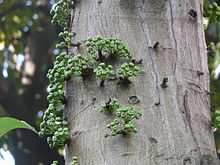Ficus variegata (plant)
| Ficus variegata | |
|---|---|
 | |
| Scientific classification | |
| Kingdom: | Plantae |
| (unranked): | Angiosperms |
| (unranked): | Eudicots |
| (unranked): | Rosids |
| Order: | Rosales |
| Family: | Moraceae |
| Genus: | Ficus |
| Subgenus: | Sycomorus |
| Species: | F. variegata |
| Binomial name | |
| Ficus variegata (Blume, 1825) | |
| Synonyms | |
|
List
| |
Ficus variegata is a well distributed species of tropical fig tree. It occurs in many parts of Asia, islands of the Pacific and as far south east as Australia. There is a large variety of local common names including common red stem fig, green fruited fig and variegated fig. A non strangling fig which may reach 30 metres in height. In Australia the fruit are eaten by Cassowaries and Double-eyed Fig Parrots.[1]
Taxonomy
Ficus variegata has been described by Carl Ludwig Blume in 1825. In 1965, E. J. H. Corner updated the species by putting some other Ficus in synonymy with F. variegata varieties.[2] Five were listed: F. variegata var. variegata distributed on all the species range, F. variegata var. chlorocarpa from South China, Hainan Island and Thailand, F. variegata var. garciae described as inhabitant of the Pacific Islands (Ryukyu islands, Taiwan and Philippines), F. variegata var. ilangoides in Luzon and northern Borneo, and F. variegata var. sycomoroides in the Philippines and Borneo. Recently, all the varieties have been synonymized under Ficus variegata.[3] Ficus variegata belongs to the subgenus Sycomorus section Sycomorus subsection Neomorphe.


Ecology
Ficus variegata is pollinating by fig wasps from the genus Ceratosolen as all the fig species from the subgenus Sycomorus. The figs of Ficus variegata have been reported to be eaten by 41 animal species (5 birds, 15 bats, 7 monkeys, 7 marsupials):[4]
- Southern Cassowary
- Blyth's Hornbill
- Yellow-crested Cockatoo
- Double-eyed Fig Parrot
- Japanese White-eye
- Common echymipera
- Long-nosed echymipera
- Raffray's bandicoot
- Ground cuscus
- Northern common cuscus
- Stein's cuscus
- Common spotted cuscus
- Lesser short-nosed fruit bat
- Horsfield's fruit bat
- Greater short-nosed fruit bat
- Indonesian short-nosed fruit bat
- New Guinea naked-backed fruit bat
- Lesser naked-backed fruit bat
- Long-tongued fruit bat
- Broad-striped tube-nosed fruit bat
- Common tube-nosed fruit bat
- Eastern tube-nosed bat
- Lesser tube-nosed fruit bat
- Greater musky fruit bat
- Great flying fox
- Geoffroy's rousette
- Common blossom bat
- Celebes crested macaque
- Javan surili
- Red-shanked douc
- Lar gibbon
- Silvery gibbon
- Agile gibbon
- Bornean orangutan
- Rattus rattus
References
- ↑ Hyland, B. P. M.; Whiffin, T.; Zich, F. A. et al. (Dec 2010). "Factsheet – Ficus variegata". Australian Tropical Rainforest Plants. Edition 6.1, online version [RFK 6.1]. Cairns, Australia: Commonwealth Scientific and Industrial Research Organisation, through its Division of Plant Industry; the Centre for Australian National Biodiversity Research; the Australian Tropical Herbarium, James Cook University. Retrieved 16 Mar 2013.
- ↑ Corner, E. J. H. (1965). "Check-list of Ficus in Asia and Australasia with keys to identification". The Gardens' Bulletin Singapore. (digitised, online, via biodiversitylibrary.org) 21 (1): 1–186. Retrieved 5 Feb 2014.
- ↑ Berg, C.C. & Corner E.J.H. (2005). "Moraceae". Flora Malesiana. I 17 (6). ISBN 1-930723-40-7.
- ↑ Shanahan, M.; Compton, S.G.; So, S. & Corlett, R. (2001). "Fig-eating by vertebrate frugivores: a global review". Biological Reviews 76: 529–572. doi:10.1017/S1464793101005760.